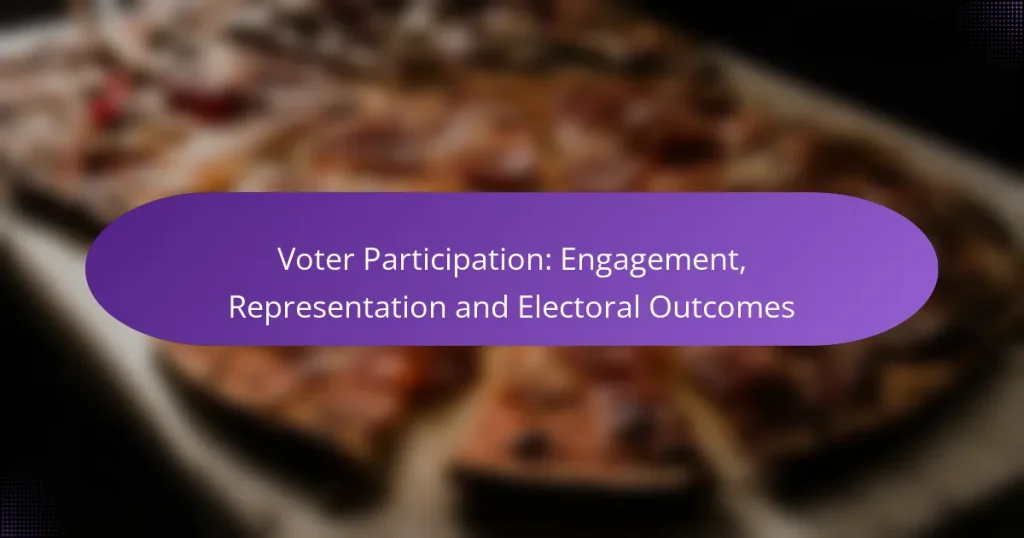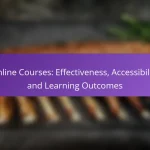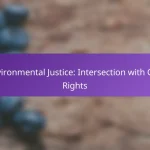Voter participation is crucial for a healthy democracy, as it directly impacts representation and electoral outcomes. Engaging citizens through outreach, simplifying the voting process, and fostering civic responsibility are essential strategies to enhance turnout. However, barriers such as misinformation and legal restrictions can impede this engagement, leading to skewed results that may not reflect the electorate’s true preferences.
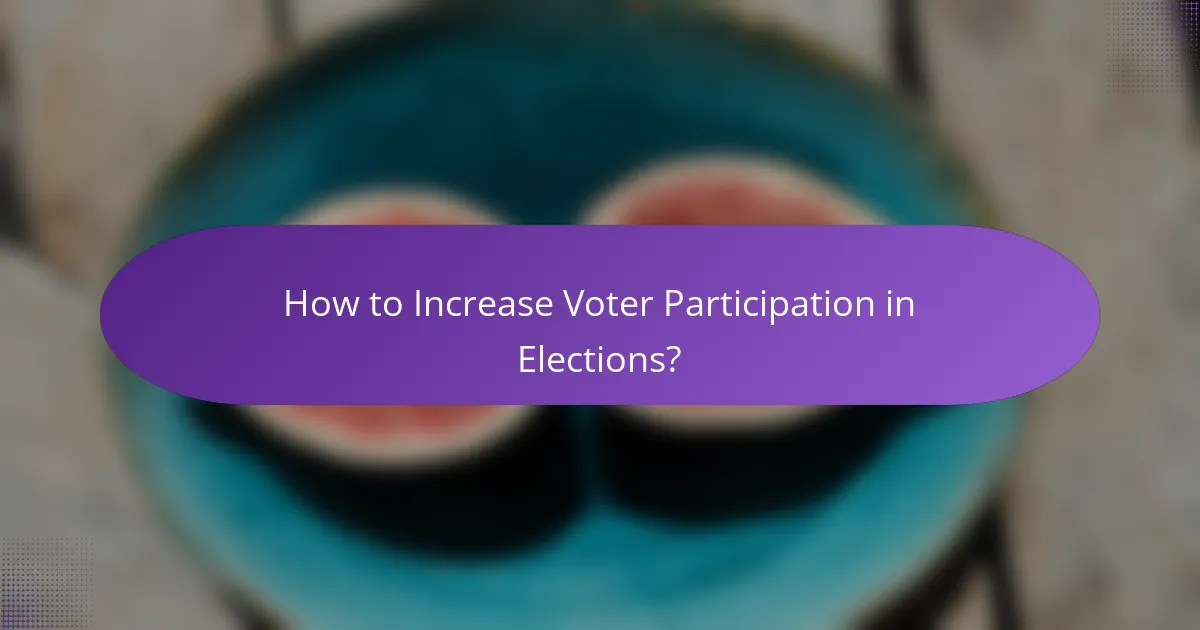
How to Increase Voter Participation in Elections?
Increasing voter participation in elections involves implementing strategies that engage citizens, simplify the voting process, and promote the importance of civic duty. Effective methods include community outreach, online registration, and educational campaigns that empower voters to make informed decisions.
Community outreach programs
Community outreach programs play a crucial role in raising awareness about upcoming elections and encouraging voter participation. These initiatives can include door-to-door canvassing, town hall meetings, and informational booths at local events.
By directly engaging with residents, outreach programs can address specific concerns and misconceptions about the voting process, making it more accessible. Collaborating with local leaders and influencers can amplify these efforts and foster trust within the community.
Online voter registration
Online voter registration simplifies the process, making it easier for individuals to register or update their information. Many states in the U.S. and countries in Europe allow citizens to register online, which can significantly increase participation rates.
Ensuring that the online registration system is user-friendly and secure is essential. Providing clear instructions and support can help those unfamiliar with technology navigate the process effectively.
Incentives for voting
Offering incentives for voting can motivate individuals to participate in elections. Common incentives include discounts at local businesses, entry into raffles, or even paid time off from work to vote.
These incentives can be particularly effective in communities with historically low turnout rates. However, it is important to ensure that these incentives comply with local election laws and do not create ethical concerns.
Education campaigns
Education campaigns are vital for informing voters about the electoral process, candidates, and issues at stake. These campaigns can take various forms, including social media outreach, public service announcements, and workshops.
Focusing on key topics such as how to vote, understanding ballots, and the importance of local elections can empower citizens to make informed choices. Tailoring educational materials to specific demographics can enhance their effectiveness.
Partnerships with local organizations
Forming partnerships with local organizations can enhance efforts to increase voter participation. Nonprofits, schools, and community groups can collaborate to host events, provide resources, and mobilize volunteers.
These partnerships can leverage existing networks to reach underrepresented populations and ensure that diverse voices are heard in the electoral process. Building strong relationships with these organizations can lead to sustained engagement beyond election cycles.
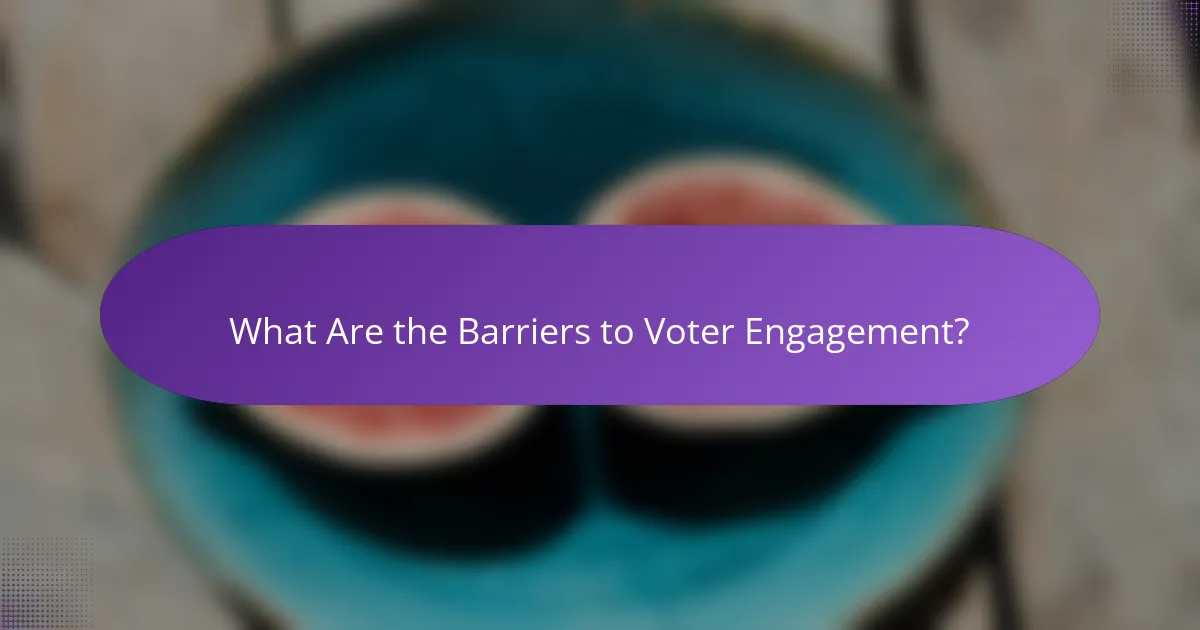
What Are the Barriers to Voter Engagement?
Barriers to voter engagement can significantly hinder participation in elections. These obstacles range from lack of information to legal restrictions, impacting overall electoral outcomes.
Lack of information
A significant barrier to voter engagement is the lack of accessible information about the voting process. Many potential voters may not know when elections are held, how to register, or what identification is required.
To combat this, local governments and organizations can provide clear, concise resources through websites, social media, and community outreach programs. Ensuring that information is available in multiple languages and formats can also increase accessibility.
Voter ID laws
Voter ID laws can restrict participation by requiring specific forms of identification that not all citizens possess. These laws vary by state and can create confusion about what is acceptable.
For example, some states may accept a driver’s license, while others might require a government-issued photo ID. It’s crucial for voters to verify their state’s requirements ahead of time to avoid being turned away at the polls.
Accessibility issues
Accessibility issues can prevent individuals with disabilities from participating in elections. Physical barriers at polling places, such as lack of ramps or accessible voting machines, can deter voters.
To improve accessibility, jurisdictions should ensure that all polling locations comply with the Americans with Disabilities Act (ADA) standards. Additionally, offering mail-in ballots and early voting options can help accommodate those who may struggle to vote in person.
Disenfranchisement
Disenfranchisement occurs when certain groups are systematically excluded from voting, often due to legal restrictions or socioeconomic factors. This can disproportionately affect minorities and low-income individuals.
Efforts to address disenfranchisement include advocating for policy changes that restore voting rights to felons and promoting initiatives that encourage voter registration among underrepresented communities. Engaging local organizations can also help raise awareness and mobilize efforts to increase participation.
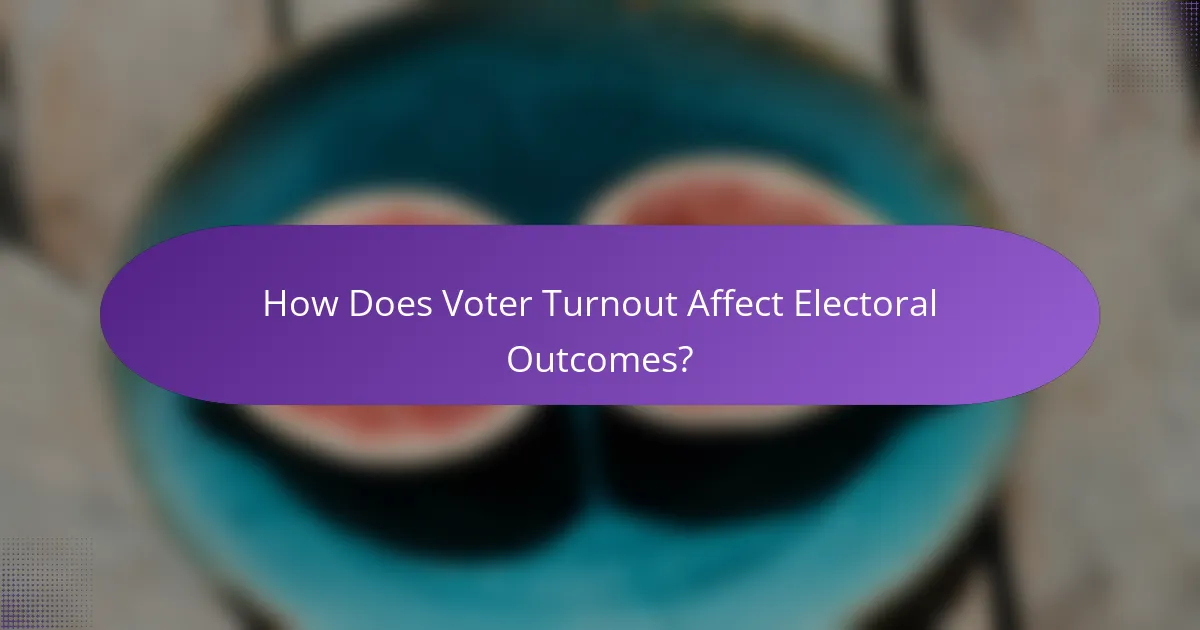
How Does Voter Turnout Affect Electoral Outcomes?
Voter turnout significantly influences electoral outcomes by determining which candidates and policies gain support. Higher participation often leads to more representative results, while low turnout can skew outcomes towards specific demographics or interests.
Impact on election results
Election results are directly affected by voter turnout, as higher engagement typically favors candidates who appeal to broader audiences. For instance, in competitive elections, a turnout increase of just a few percentage points can shift the outcome, especially in closely contested districts.
Conversely, low turnout may benefit candidates with strong support among a smaller, dedicated base. This dynamic can lead to elected officials who do not reflect the preferences of the majority of the population.
Representation of demographics
Voter turnout plays a crucial role in the representation of various demographics. When certain groups, such as young voters or minorities, participate at lower rates, their interests may be underrepresented in government decisions and policies.
Efforts to increase turnout among these demographics, such as outreach programs and education campaigns, can help ensure that elected officials consider a wider range of perspectives and needs.
Influence on policy decisions
Higher voter turnout can lead to policy decisions that better reflect the electorate’s preferences. When more citizens engage in the voting process, elected officials are incentivized to address the concerns of a larger segment of the population.
In contrast, low turnout can result in policies that cater to the interests of a vocal minority, potentially neglecting broader societal needs. Engaging more voters can help create a more balanced and equitable policy landscape.
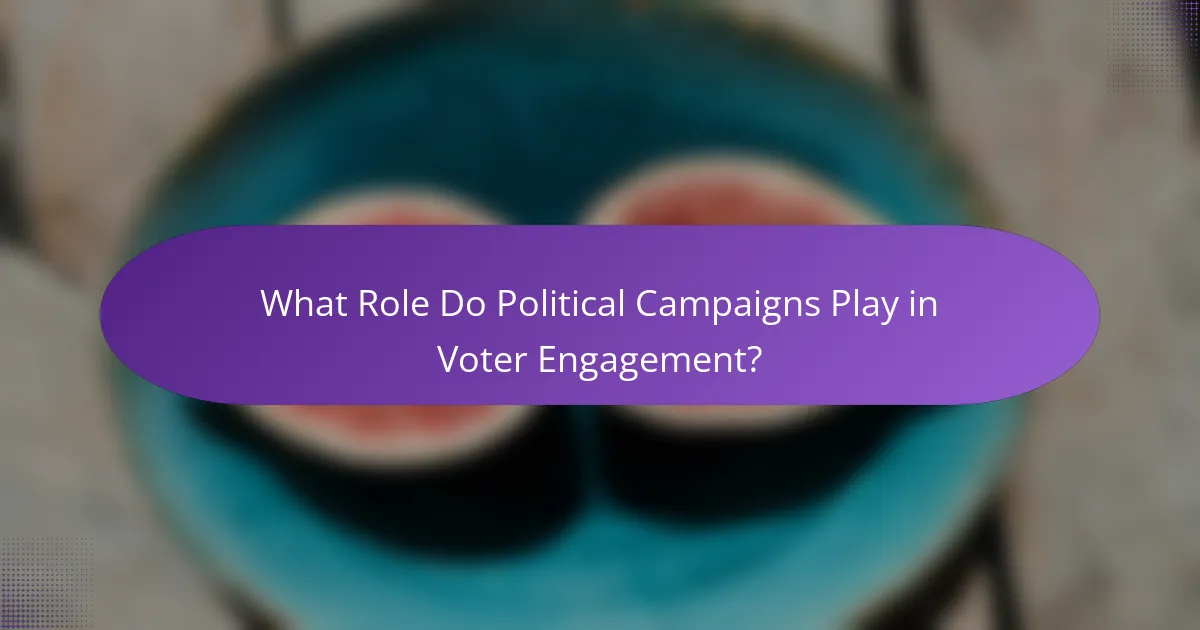
What Role Do Political Campaigns Play in Voter Engagement?
Political campaigns are crucial for enhancing voter engagement by informing and motivating citizens to participate in elections. They employ various strategies to connect with potential voters, ensuring that their messages resonate and drive turnout.
Targeted messaging
Targeted messaging involves tailoring campaign communications to specific demographics, interests, and concerns of voters. By analyzing data, campaigns can craft messages that address the unique needs of different groups, such as young voters, minorities, or suburban families.
Effective targeted messaging can significantly increase engagement. For instance, a campaign might focus on climate change for younger voters while emphasizing economic stability for older demographics. This approach helps ensure that the campaign’s message is relevant and compelling.
Use of social media
Social media platforms are essential tools for modern political campaigns to engage voters. Campaigns utilize platforms like Facebook, Twitter, and Instagram to share information, mobilize supporters, and create a sense of community among voters.
By leveraging social media, campaigns can reach a wider audience quickly and cost-effectively. They can run targeted ads, share live updates, and encourage user-generated content, which can amplify their reach and foster deeper connections with potential voters.
Grassroots mobilization
Grassroots mobilization focuses on building support from the ground up, often involving local volunteers and community organizations. This strategy empowers individuals to take an active role in the campaign, fostering a sense of ownership and commitment among supporters.
Successful grassroots efforts can include door-to-door canvassing, phone banking, and organizing local events. These activities not only raise awareness but also create personal connections that can motivate individuals to vote, particularly in local elections where turnout can be significantly impacted by community engagement.

What Are Effective Strategies for Engaging Young Voters?
Effective strategies for engaging young voters include leveraging digital platforms and fostering personal connections. By utilizing social media and peer outreach, organizations can significantly increase participation among this demographic.
Social media campaigns
Social media campaigns are a powerful tool for reaching young voters, as they spend considerable time on platforms like Instagram, TikTok, and Twitter. These campaigns should focus on creating visually appealing content that resonates with youth culture and addresses issues important to them, such as climate change, education, and social justice.
To maximize impact, campaigns can utilize targeted ads and influencer partnerships to amplify their message. Engaging content, such as videos, polls, and interactive stories, can drive higher engagement rates and encourage sharing, further expanding reach.
Peer-to-peer outreach
Peer-to-peer outreach involves mobilizing young individuals to engage their friends and networks about voting. This approach leverages trust and familiarity, making it more likely that peers will influence each other positively regarding electoral participation.
Effective methods include organizing events like voter registration drives or informational sessions led by young leaders. Providing resources, such as scripts or social media toolkits, can empower these peers to communicate effectively about the importance of voting and upcoming elections.
